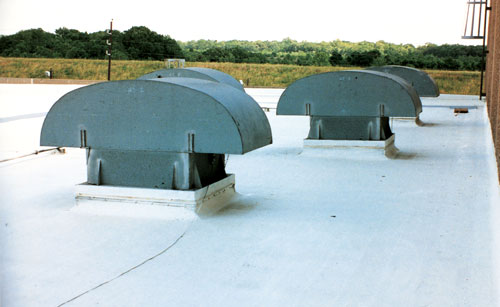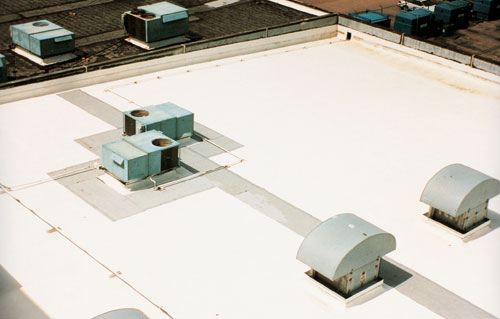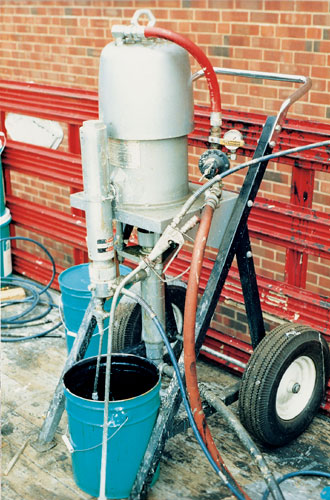Energy-efficient roof systems increasingly are in demand. Rising energy costs, evolving building codes and greater sensitivity to the effects of urban heat islands all are reasons to specify white, reflective roof systems. It is common sense that using energy-efficient roofing materials results in cooler roof surfaces and less energy spent for air conditioning.
As a result of this demand and media attention in recent years about ENERGY STAR® ratings and reflectivity, acrylic coatings frequently are specified as finish coats for built-up and modified bitumen roof systems and maintenance coatings for existing roof systems, including built-up, modified bitumen, metal, spray polyurethane foam and concrete.

Photo provided by Tremco Inc., Beachwood, Ohio.
Acrylic coatings can provide an attractive, durable finish for smooth bituminous roof systems.
In addition, some energy codes have begun to include minimum requirements for reflectivity and emissivity (a surface's ability to emit heat). For example, the Cool Roof Rating Council has developed a system to evaluate and label roof coverings using independent testing labs so credible energy performance values for all roof coverings can be included in energy codes.
These current trends underscore the economic and environmental benefits of white, reflective coatings.
Why white coatings?
White water-based acrylic coatings generally provide the highest reflectivity and best longevity at the most economical price with respect to material and labor costs. Because water-based acrylic coatings typically have little odor, a coating can be applied while a building is occupied and in service, making such coatings ideal for buildings that function as schools, residences, food preparation areas, hospitals and offices.

Photo provided by Tremco Inc., Beachwood, Ohio.
White acrylic coatings are highly reflective and reduce the heat buildup in roof systems when compared with dark surfaces.
From an applicator's viewpoint, water-based acrylic coatings do not require extraordinary personal protective equipment. Generally, the equipment required is no more than a pressure washer, paddle mixer and spray rig. This makes it easy for roofing contractors to enter into the coatings application market.
Specifying acrylic coatings
There are several surface preparation procedures for acrylic coatings, which follow.
For application over smooth built-up roof (BUR) systems, an asphalt emulsion must be applied to stabilize the surface. Without an asphalt emulsion, the mopping asphalt or cold-process adhesive may flow slightly and lead to surface cracking or bleed-through on the acrylic coating.
Asphalt emulsions also add additional surface waterproofing capabilities and may improve a roof system's fire resistance because of clay thickeners in the emulsions. Manufacturers generally do not recommend applying acrylic coatings to gravel-surfaced BUR systems because these roof systems' uneven surfaces lead to inconsistent coverage and potential cracking of areas where the coating is applied too heavily.
Similarly, acrylic coatings can be applied directly to granule-surfaced modified bitumen roof membranes on new roof systems or as restoration coatings. However, granules can be difficult to coat because of their rough, uneven surface areas. Moisture and air pockets can be trapped under the acrylic coating and lead to blisters or pinholes in the cured acrylic coating. Applying a compatible primer to the granule surface before coating application can minimize these concerns.
In addition, acrylic coatings are specified as reflective, restorative coatings on metal roof systems. Acrylic coatings adhere well to galvanized metal surfaces unlike solvent-based alkyd coatings, which adversely react with zinc in the galvanized layer and lead to flaking of the alkyd paint layer from the galvanized surface.
Acrylic coatings do not adhere well to Kynar® or other factory-applied metal coatings, so always test a sample for adhesion before specifying an acrylic coating on a factory-coated metal roof system.
Masonry surfaces also can be coated with acrylic coatings. It is wise to check with a coating manufacturer to ensure a particular coating is recommended for vertical or horizontal substrates before specifying it for a particular project.
Potential problems
To prevent potential application problems, it is best to identify an existing surface before specifying a coating. Unknown coated surfaces can be identified by submitting a sample to a testing lab. Once an existing surface is identified, it is possible for a qualified specifier or manufacturer to recommend the proper course of action, including the choice of coating, primer type and surface preparation.
Beware of applying an acrylic coating over aged or poorly adhered coatings and/or embrittled asphalt. Acrylic coating films develop strength and adhesion as they cure. It is possible the tension that develops in a recently applied acrylic coating film will delaminate a poorly adhered coating or bitumen layer. It is critical aged surfaces be fully inspected and evaluated by a manufacturer before application of an acrylic coating so proper surface repairs and preparation can be conducted to prevent surface delamination problems.
Special acrylic rust paints are available for application over corroded metal, but loose rust and scale must be removed by wire brushing or sanding before application. Acrylic rust paints seal a surface from moisture and oxygen, which need to be present for corrosion to form. An acrylic top coat then is applied over the rust primer to provide a finished surface.
Even with the use of primers, some existing coated surfaces may be incompatible with acrylic coatings. Certain coating types, such as silicone, Kynar and urethane, may not provide good adhesion with acrylic coatings. Adhesion problems likely will develop when an acrylic coating is applied on an incompatible surface; such problems include blistering and peeling. Consult a coating manufacturer to determine which options for recoating may be available for surface preparation and/or priming before recommending a recoat.
Curing and weather conditions
The greatest challenge with water-based acrylic coatings is installation during changing weather conditions. Virtually all parts of North America have some application limitations as a result of cold weather, daily rainstorms, high humidity and/or fog, or reduced daylight hours during winter. Problems will occur when an acrylic coating is specified on a construction project without regard to the time of year the coating is to be installed.
When an acrylic coating is applied, two physical changes must occur: Water must evaporate from the applied coating film for initial drying and acrylic polymers must fuse together for final cure.
The goal of the first change is simple but can be complicated by a variety of factors. The second change takes place during a two- to four-week period and must occur for an acrylic coating to develop its full strength; adhesion; and beneficial properties, such as moisture resistance and dirt resistance.
Drying of the coating
As an acrylic coating is applied—by spray, brush or roller—water begins to evaporate from the applied coating. The water in the coating helps the coating level itself on the surface and penetrate a substrate's small crevices. Warm temperatures, wind and sunlight increase the freshly applied coating's evaporation. The water closest to the top of the applied coating film will evaporate first. Water in the coating film closest to the substrate has to diffuse through the coating and takes longer to leave the coating.
As water dries from a coating, the coating will skin over and become dry to the touch within one hour to four hours. Most manufacturers allow for a second application coat after the first coat is dry to the touch.
When a coating is dry to the touch, it is far from fully cured. In fact, small amounts of water still are present within the recently applied coating film, and water slowly will diffuse through the coating film during the next few weeks. A coating may appear to be well-adhered and able to withstand severe weathering during the first few days, but it is not. If a coating is exposed to ponded water conditions during the drying or coating period, it may soften, lift and debond from the surface. This would require a contractor to clean the surface and reapply the coating.
Final cure
During the first few weeks after application, an acrylic polymer begins to bond to itself and form a continuous network within the coating film. This fusion is essential to the coating's long-term performance. Wet weather and cooler temperatures inhibit final cure and may prevent an acrylic polymer from properly fusing. This is why acrylic coating applications should not be attempted on roofing projects from late fall to early spring in most North American areas.
Maintenance
Acrylic coatings do not age similar to oil-based coatings, which dry out after long-term exposure and become brittle before eventually cracking and flaking. Acrylic coatings age from the outside in, which means the exposed acrylic polymer on top of the film will degrade and chalk during the long-term. Exterior chalking is evidence of aging, but beneath the chalk film, an acrylic coating will be in substantially good condition once chalking is removed. However, the coating may be slightly thinner than when first applied because of the removal of the chalked layer. Chalking must be removed by low-pressure washing before recoating or the new layer may have poor adhesion.
Acrylic coatings may pick up surface dirt. A polymer may be tacky, especially when first applied, allowing dirt to become embedded in the surface. As time passes, chalking and dirt cause reduction in reflectivity, but the reflectivity of an aged acrylic coating may be improved by pressure washing the coating surface.
Even after cleaning, a white acrylic coating may not be as reflective as when originally applied. After surface cleaning, an acrylic coating can be applied directly over most existing acrylic coating films with excellent adhesion. This is not always true with other types of coatings, such as epoxies, urethanes and alkyds. Easier recoating makes acrylics desirable on structures that must be maintained by in-house crews or buildings that cannot be closed for an extended time period. Recoating can be done regularly, such as every five years to seven years, to optimize reflectivity and extend a roof membrane's service life.
Acrylic coatings, though durable and weather-resistant, are vulnerable to the effects of moisture and cold temperatures during the curing process. They require weather conditions that favor water evaporation to initiate the curing process.
For the best long-term success with acrylic coatings, you must understand how to prepare a surface before applying a coating and ensure the coating is not exposed to improper curing conditions following coating application.
Long-term reflectivity can be maintained by surface cleaning, but best results can be achieved by recoating the surface according to a maintenance schedule.
Kurt Sosinski is a product manager for Beachwood, Ohio-based Tremco Inc.'s Building and Maintenance Division.
Tips for installing acrylic coatings
The growing interest in reflective roof coatings prompted by the U.S. Environmental Protection Agency's ENERGY STAR® program is resulting in more roofing specifications that include the application of acrylic coatings. Following are some guidelines and recommendations for proper application of acrylic roof coatings.
Preparation
A pressure-wash unit is mandatory for preparing a roof's surface for coating application. Pressure washing removes embedded dirt, chalking, carbon black and poorly adhered material. A pressure wash needs to adequately clean the surface without damaging adhered roofing laps, masonry or flashings. A typical pressure wash is conducted at 800 pounds per square inch (psi) (5516 kPa) to 1,500 psi (103425 kPa).
Clear-rinsing cleaning solutions may be used to improve the cleaning action of high-pressure water. When pressure washing a surface, be aware of any local restrictions regarding how the wash-off water must be treated or released into storm sewers or swales.
Priming
Primers prepare a roof's surface and improve a final coat's bond to the surface. Primers and priming recommendations may be specified by coating suppliers, and supplier's recommendations should be followed for curing and open time. A variety of primers may be specified as a base for acrylic coatings. They include the following:
Primers are not intended for long-term weather exposure, so it is important to coat a primer with an acrylic coating as soon as it cures and prime it again if the primer surface has become contaminated with dirt or debris or exceeded its recommended open time.
Acrylic coatings
Application
A spray pump capable of developing 1,800-psi (124110-kPa) material output pressure should be sufficient to spray a variety of acrylic coatings. Spray pumps with less pressure output may be suitable depending on a coating's viscosity. A siphon hose on the material inlet typically is used to draw material directly from 5-gallon (19-L) pails or barrels.
Self-contained hydraulic pumps with gas engines are preferred by many applicators because such pumps are portable. Pneumatic pumps driven by air compressors also are acceptable.

Photo provided by Tremco Inc., Beachwood, Ohio.
A pneumatic pump can be used to spray apply acrylic coatings. Other spray-pump systems may be used as specified by a manufacturer.
Spray hoses must be able to safely handle a pump's working pressure, so it is important to inspect hoses and fittings daily to minimize the risk they will burst and cause injuries or expensive cleanup.
A spray gun with an extender wand allows for comfortable coating application without having to hold the spray gun uncomfortably close to the surface. A coating supplier will recommend spray tip sizes. A reversible style tip and housing will allow fast clearing of occasional tip clogs. Eventual wearing of spray tips can be detected when the spray-fan pattern becomes wider and begins to scatter material at the edges.
Proper spray technique involves keeping a gun level with a roof's surface at all times, maintaining a consistent distance between the spray tip and surface, and overlapping the spray pattern to ensure proper coverage and an even appearance.
Pumps need to be appropriately washed at the end of a project to ensure readiness for the next project. When clearing acrylic coatings from pump and spray lines, it is best to flush water through the lines to remove the coating, then pump through isopropyl alcohol to remove traces of water. (Water may corrode internal metal parts during long-term storage.)
Pump packings periodically will require maintenance and replacement based on use. If a pump does not properly pressurize or move the material or excessive amounts of coating leak from the top piston, the pump packing may be damaged. Check with the equipment manufacturer for specific recommendations based on the pump model.
Acrylic coating formulas
Acrylic coatings primarily are formulated with pigments, acrylic polymers and water. There may be other additives, such as fibers for reinforcement, glycol for freeze/thaw resistance, intumescent or other fire-retardant additives, or biocides to prevent fungal growth in the container.
Pigments, such as titanium dioxide, produce the white color, which provides the desired ENERGY STAR®-compliant reflectivity. Acrylics easily are tinted with compatible color-shading pastes. To achieve darker shades, a manufacturer will reduce the amount of white pigment. Coatings can be field-tinted, but tinting from the manufacturer is recommended to ensure the desired color can be achieved and properly mixed. As expected, reflectivity decreases with darker shades.
ENERGY STAR listings are specific to a coating formula. Tinted versions of a white coating should be tested to meet ENERGY STAR criteria because the reflectivity of a tinted formula could be much different from a white coating.
In addition, when a manufacturer makes a substantial change in coating formulation, such as changing the base acrylic latex, the coating must be tested and recertified before re-establishing the ENERGY STAR listing for that coating. This includes testing the reflectivity of this formula on three roof systems that each are at least three years old.
COMMENTS
Be the first to comment. Please log in to leave a comment.